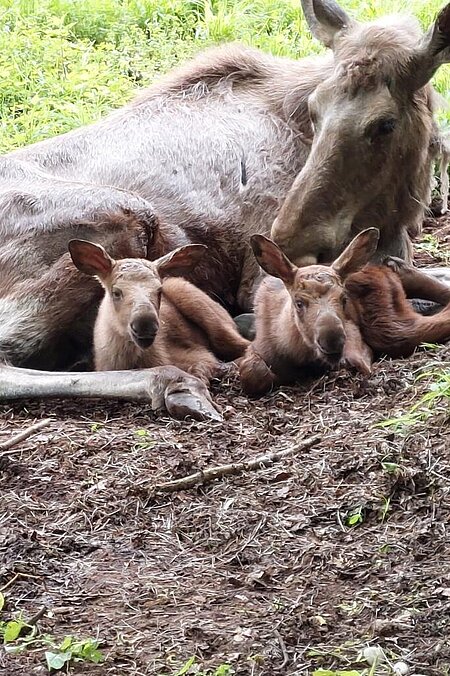![[Translate to English:] [Translate to English:] Zwei Elch-Jungtiere mit ihrer Mutter.](/fileadmin/_processed_/2/7/csm_tierpark-hellabrunn-elch-jungtiere-kaelber-europa_1bba873c0d.jpg)
Hellabrunn Zoo welcomed the birth of two elk calves in late May. The twins, a boy named Xantorin and a girl named Xyntia, underwent their first health check by the vets last week.
In the coming weeks, visitors will be able to meet the newborns as they make their first forays in the outdoor enclosure. Female elk typically give birth in early summer. The young then stay with their mother until the following spring. The newborn twins are adorable mini versions of mum Beate: elk calves are typically between 70 and 80 cm tall at birth and around 80 to 100 cm long – which is roughly the length of an adult cow’s head. In addition to feeding on their mother's milk, the calves have now begun to nibble on grass to supplement their diet. At about three weeks old, they will also be able to start chewing on twigs. Beate will nurse her calves until late autumn, by which time they will already weigh over 100 kg. But there is still a long way to go until then for the Hellabrunn twins. At present, the male calf tips the scales at 15.4 kg. His sister is slightly lighter at 12.3 kg.
European elk at Hellabrunn Zoo – a breeding success story
The birth of the two healthy calves has delighted everyone at Hellabrunn Zoo, as zoo director Rasem Baban explains: “Elk play an important role in biodiversity in Germany and Europe. They are considered to be the largest member of the deer family. Their superior height is mainly due to their long legs - a useful adaptation that helps them survive in the swampy forests of their natural habitat. Long legs enable the elk to overcome obstacles and thus move around freely even on muddy or marshy ground. Another feature that helps them with this is their special hooves: Elk have cloven or two-toed hooves. They can spread their hooves and the skin between to act like webbing to prevent their feet from sinking too deeply."
For Carsten Zehrer, head of the zoology department at Hellabrunn Zoo, the successful birth is wonderful news to get visitors excited about this fascinating species: "Since the arrival of two adult females from a zoo in Sweden last autumn, the three cows and one bull now living together in the enclosure have been getting along very well. We are therefore all the more delighted about the birth of the two healthy calves to our original breeding pair. So far the male and female calves have been staying in the rear section of the enclosure with mum Beate, but soon they will start to explore the enclosure together. As for two female adults who arrived here in 2022, maybe it will work out for them next year."
Elk in Germany – welcoming good neighbours
European elk live as solitary animals in sparse forests with fallow areas, floodplains, swamps and clearings. During the cold winter months they live together in loose communities. The magnificent Nordic ungulates feed primarily on grasses, scrubs and leaves, but will also eat shoots and bark. Their tough, cartilaginous upper lip enables them to break branches from trees and strip bark.
Approximately 100 years after being wiped out in Germany, elk are now returning. Small populations from the forests of Poland have crossed the border and resettled in Brandenburg and Mecklenburg-West Pomerania. There have also been sightings in Bavaria of elk that have wandered into the Free State from the Czech Republic.
Like all herbivores, elk modify their habitat through selective grazing. They are therefore known as ecosystem engineers. Elk have a significant impact on species richness and heterogeneity of forests through their choice of food and thus make a positive contribution to biodiversity in their habitats.
